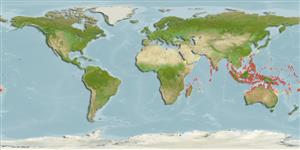>
Kurtiformes (Nurseryfishes, cardinalfishes.) >
Apogonidae (Cardinalfishes) > Apogoninae
Etymology: Sphaeramia: Greek, sphaira = ball + Greek, amia = a kind of shark (Ref. 45335).
More on author: Cuvier.
Environment: milieu / climate zone / depth range / distribution range
Écologie
marin récifal; profondeur 0 - 5 m (Ref. 9710). Tropical; 31°N - 27°S, 32°E - 173°W
Indo-Pacific: East Africa to Kiribati, north to the Ryukyu Islands, south to New Caledonia; Belau to eastern Caroline and Mariana Islands in Micronesia.
Length at first maturity / Taille / Poids / Âge
Maturity: Lm ?, range 6 - ? cm
Max length : 10.0 cm TL mâle / non sexé; (Ref. 4329); common length : 8.9 cm SL mâle / non sexé; (Ref. 37816)
Épines dorsales (Total) : 8; Rayons mous dorsaux (Total) : 9; Épines anales: 2; Rayons mous anaux: 9. Greenish grey, with dark vertical bar from origin of spiny dorsal to just in front of anus; scattered spots on body, head and 1st dorsal membrane; pelvic fins dark (Ref. 4329, 48635).
Restricted to coastal waters, forming small aggregations among mangroves, rocks, debris, or piers of shallow sheltered shorelines. Feeds at night (early evening and just before day break), primarily on planktonic crustaceans. Courtship and spawning occur fortnightly (shortly before new moons and full moons). Eggs are incubated by the male for about 8 days. Larval phase pelagic. Sexual maturity is attained at 7 cm by males and at 6 cm by females (Ref. 1602).
Courtship and spawning occur on a semi-lunar cycle, shortly before full and new moons (Ref. 37816). Distinct pairing during courtship and spawning (Ref. 205). Are mouthbrooders (Ref. 240). Males incubate up to 12,000 eggs for a period of about 8 days (Ref. 37816). After the pelagic larval phase, juveniles settle and grow at a rate of 3 to 6 mm per month (Ref. 37816).
Gon, O., 1986. Apogonidae. p. 546-561. In M.M. Smith and P.C. Heemstra (eds.) Smiths' sea fishes. Springer-Verlag, Berlin. (Ref. 4329)
Statut dans la liste rouge de l'IUCN (Ref. 130435)
Menace pour l'homme
Harmless
Utilisations par l'homme
Pêcheries: intérêt commercial mineur
Outils
Articles particuliers
Télécharger en XML
Sources Internet
Estimates based on models
Preferred temperature (Ref.
123201): 26.3 - 29.3, mean 28.6 °C (based on 2452 cells).
Phylogenetic diversity index (Ref.
82804): PD
50 = 0.7500 [Uniqueness, from 0.5 = low to 2.0 = high].
Bayesian length-weight: a=0.02138 (0.01194 - 0.03827), b=3.07 (2.91 - 3.23), in cm total length, based on LWR estimates for this species & (Sub)family-body (Ref.
93245).
Niveau trophique (Ref.
69278): 3.6 ±0.51 se; based on food items.
Résilience (Ref.
120179): Haut, temps minimum de doublement de population inférieur à 15 mois (Preliminary K or Fecundity.).
Fishing Vulnerability (Ref.
59153): Low vulnerability (10 of 100).
Nutrients (Ref.
124155): Calcium = 159 [79, 274] mg/100g; Iron = 1.01 [0.55, 1.79] mg/100g; Protein = 18.8 [17.5, 20.0] %; Omega3 = 0.109 [0.059, 0.200] g/100g; Selenium = 21.7 [10.4, 46.4] μg/100g; VitaminA = 60.9 [17.3, 211.0] μg/100g; Zinc = 1.79 [1.13, 2.78] mg/100g (wet weight);
